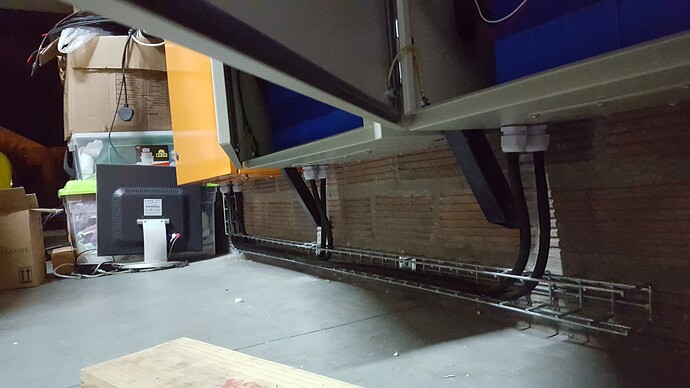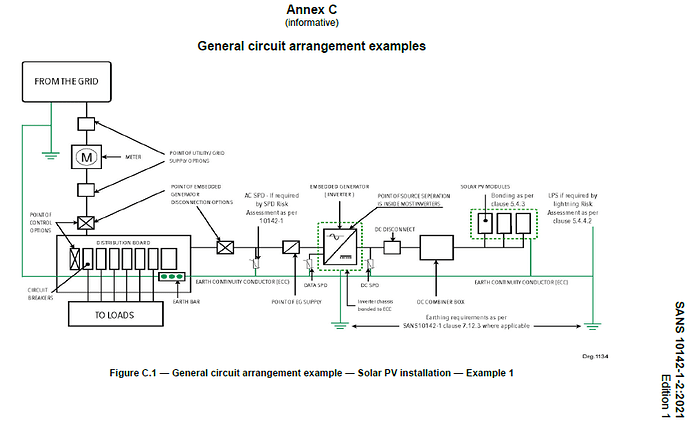At least we’ve now got a heads-up.
The 5/50/5m quantity or length is a bit confusing, but the fact that it has to be in metal trunking does sound like what they want it to be.
Now my question is what is seen as metal trunking. Pipes are a pain and if you need to bend those like @JacoDeJongh mentioned it can be a real pain.
Is something like what @Gman did with his install here also metal trunking, because that does look like a very neat and easier way to do it. Would this be allowed?

The screened cable / trunking requirement is from this section:
So it makes sense that the grid-type cable trays would be sufficient. It could feasibly depend on the cables being “inside” or just “on-top”.
Just to clarify, even though I brought it up, please do not interpret the “greater than 5” to mean anything except for meters at this point. That would be the plain reading, and works given everything else we know. I was being facetious given the very late point where this came up. I do believe that people could interpret as something else, but please please don’t go down that road now.
Nothing really said about this, would this mean I need a disconnect outside my house or is in the garage okay?
Where would this be from panel to DC box, or from DC box to MPPT? If the first one, it would be killer as have 2 series in 5 parallels strings on two MPPT’s, would this mean 5 disconnects and then would need to extend my DC wires a lot, lets not then even get to the galv conduit cost and difficulty involved.
I know in some American states, your AC-coupled PV feeds in at the meter just outside your house (where the meter man comes to read it), and there is signage and a big old switch there so they can switch that off (for additional safety) if they need to work on it.
If they had simply copied this from one of those countries… it creates all sorts of questions about DC-coupling and hybrid inverters (I mean… you can cut the DC-supply, but the batteries and the inverter are inside and they are still on…).
I think this is for the grid supply, i.e. Eskom can trip it if they need to. I assume they’d turn off the line to work on it, see your end is still live, trip it & lock it out, and start working while HQ sends you a fine. ![]()
Edit: Because your end is supposed to be dead automatically given all the anti-islanding requirements. If they see you’re islanded, they have a disconnect available. The lock-out requirement is standard when performing maintenance, so it follows that for safety reasons ALL possible supplies need to be locked out.
A fairly simple switch-off that I’ve seen in workshops is a big old red “STOP” button that simply leaks an amount across the RCD, causing it to trip.
The other fairly easy solution is a switch that simply switches the whole house off, including whatever you have there that is islanding.
I must say, Tariq asked the other day about marking something as an off-grid standby sseg even though it is not… this kinda makes you want to do that.
I think we need to read this as “enclosed” so the cable tray will not suffice unless you put a cover over it (which exists and can be done). But I would recommend against it, rather use enclosed conduits/trunking that can assist with UV protection, our sun is evil (aka our UV is a bit higher than the international norms, and thus we look old compared to those guys in the north)!
They are quite clear on this actually on where it should be. The Supplier is defined as the utility (aka Eskom, CoCT, City Power). So installing it inside the garage will limit accessibility.
As per
This is where it originated. Here is also the given diagram on a typical single phase installation:
So from the diagram it seem you put the disconnect between the meter and the DB. My meter is way there is the street in the utility distribution box where the utility disconnect is as well. Would that not suffice as the needed disconnect?
I meen the utility will go to that distribution box and disconnect each each, and not walk the each house and disconnect there? Or am I missing something?
It needs to be a lockable isolator. The switchgear in that box is usually not lockable.
Also, I believe that it needs to be under your control as well.
While I agree it would make sense to have it in the Municipal box, the standard is written as having it on your boundary. Thus preventing “energisation” of the cable between the municipal box and your embedded generation.
Would that mean that if you lock it the utility will have to arrange with you to be able to disconnect it? That might not be very practical, but at least it would be the utility’s problem. I guess they can just disconnect then at the distribution as well, which I would see them doing rather trying to arrange with you.
Often, lockable disconnects can only be locked in the off state. This is so that you can turn it off to work on the line and lock it so that nobody can turn it back on while you are busy.
Edit: In some big organizations, you get disconnectors that can take multiple locks then each person working on the line puts their own lock on the disconnect and it can only be switched back on once all the locks are removed.
So are you saying its the AC into my house (not DC on the roof), that is cheaper, although don’t love the idea of the neighbors being able to turn my power off.
Would the think the dual anti islanding relay would be enough… would think its as easy as house A G J have grid connected systems then switch us off at the street curb then lock that box. Understand its not the usual lockout and locked off
I think this is defense-in-depth: although all the equipment on the other side for the boundary wall should have that capability, it might not (see various “Axperts / XXX are fiiiiine” threads). A lockout at the boundary is visually inspectable at the time of maintenance by the personnel performing the maintenance, so it makes sense to add. Especially since it solves the problem completely in that case, regardless of what is going on the inside.
(The lockout disconnector on its own wouldn’t suffice because the “island” in anti-islanding can get quite big when things go sufficiently wrong.)
Yes, please no DC isolators. The fires in Aus is a good enough warning on that one! Look at the image I shared it can be either the connection into your main DB or it could be between Main DB and Inverter. And yes, it is the “defence-in-depth” argument here.
In Germany it is, but they believe their technicians are suitably trained. In South Africa we write standards based on the most untrained individuals and try to use procedure to curb stupidity…
When I did my install, I read the draft regulations and saw the 50m metal conduit clause. Although my runs from the roof to the inverter is less than 50m, I decided to run each string in metal sprague.
Will this suffice as it can be seen as a conduit? It’s also a lot easier to work with than solid metal conduit where the bends would be a nightmare.
I also read that in the draft;
From:
DRAFT: SANS 10142-1-2:20XX
Edition 1
Disclaimer: I am clueless about these SANS docs
One would expect that a draft was well thought of and would be pretty close to the final version but I guess that’s not a fair assumption to make.
The draft even says consideration should be given. Meaning it’s not compulsory.
Now it just seems like someone pushed this out quickly to secure some year end bonus.
If a lock out switch accessible to Escom technicians has to be installed outside your property, safety must also be a consideration.
Remember that trick where criminals would turn off the water in the street to lure you out of the house at night?
If installing a switch which you must give access to, then it might as well be inside your property.
Additional cost aside, I actually think the requirement for metal conduit is a good thing since metal conduit helps to reduce RFI and just as with air, light and noise pollution, radio frequency pollution is becoming a bigger and bigger problem and unfortunately PV systems is one of the big culprets.
Now that could be interesting as well. At my place, a sparky could use a ladder (he should have one on the vehicle), scale the wall, and turn off the breaker (which would be on an ouside wall, labelled, etc). But at my previous place, he would not be able to get in, since the place had electric fencing.
I also suspect that having to scale a wall probably doesn’t fit the legal definition of “accessible”. Especially if you also own a dog.
If the switch is fitted to the outside wall (or similar), I’d put it in a clearly marked box that needs a screwdriver to be opened. The Sparky will have one. Most opportunistic walker-by-criminals probably won’t.
But that’s about the best I can do.

